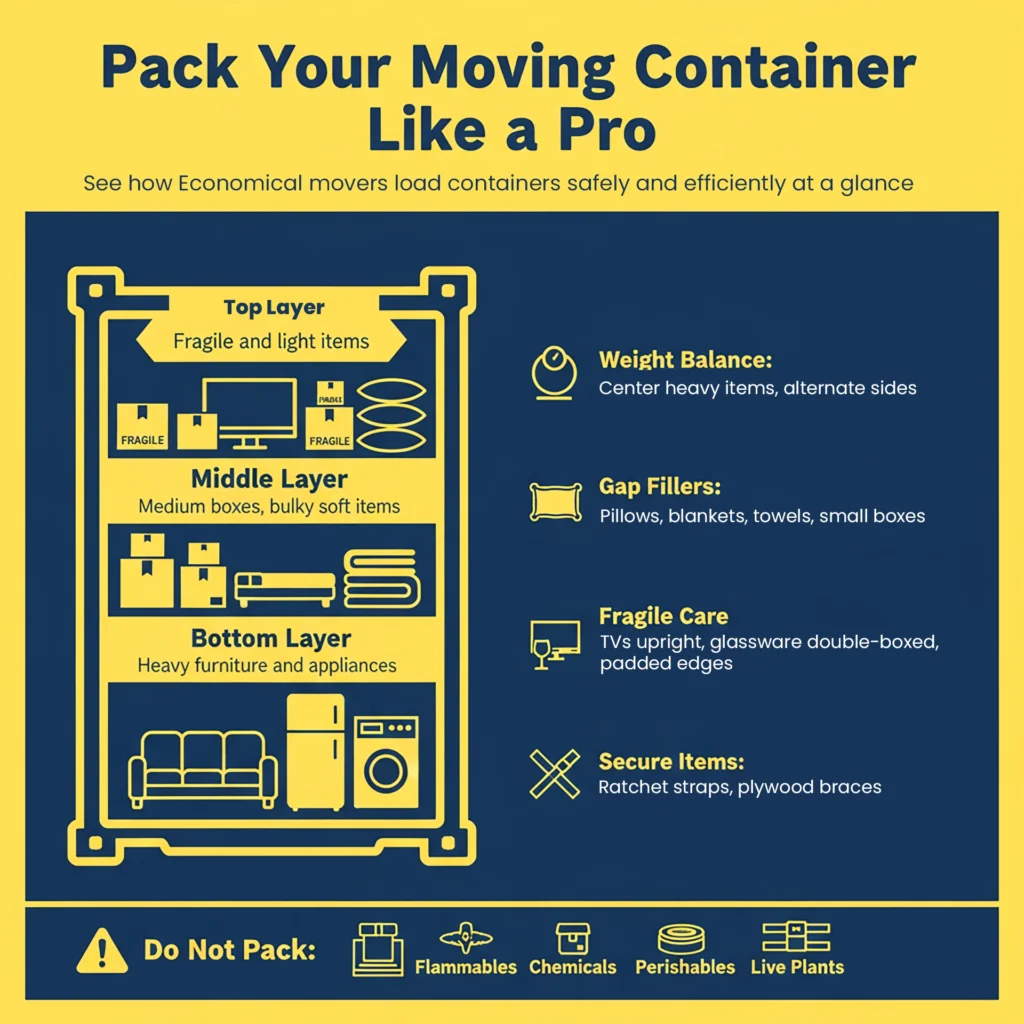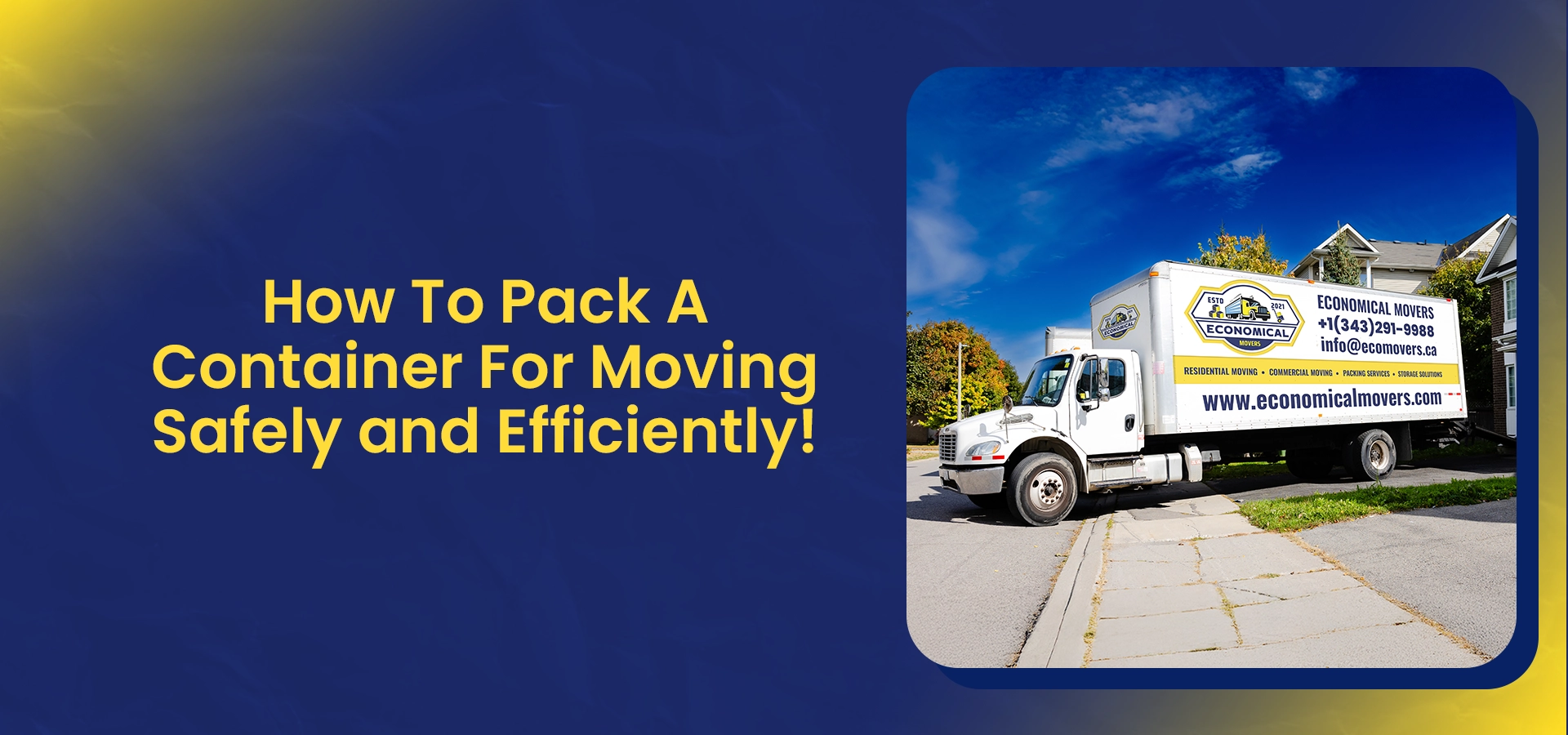Discover expert packing methods for your container for moving. Keep your belongings secure, balanced, and damage free during relocation.
Moving is already challenging, and figuring out how to pack a container for moving can make it feel impossible. Items shift, boxes collapse, and it is easy to forget the safest way to protect your belongings. People often waste space or risk breaking valuable furniture.
At Economical Movers, we have been guiding clients across Canada since 2021, helping them pack containers securely and efficiently. Our expertise ensures that every item has its place, nothing gets damaged, and you can feel confident throughout the move.
In this article, we’ll share the professional techniques we use daily, helping you pack your container with confidence and maximize every inch of space.
Items You Need To Start Packing A Moving Container
Before you start throwing things into your moving container, it helps to gather the essentials. Having the right supplies makes the whole process smoother and safer.
- Boxes: Various sizes for different items.
- Packing Tape: Strong and durable for sealing boxes.
- Moving Blankets: Protect furniture and appliances from scratches.
- Bubble Wrap & Foam: Cushion fragile items like glass and electronics.
- Ratchet Straps or Ropes: Secure items and prevent shifting.
- Moisture Absorbers: Keep clothes, papers, and electronics safe from dampness.
- Labels & Markers: Identify fragile or priority boxes.
- Declutter First: Donate, sell, or discard items you don’t need to save space and money.
- Prepare Large Items: Unplug and drain appliances; wrap furniture corners.
- Prepare electronics: Pack upright, add padding, and remove batteries.
Eco Friendly Alternatives To Bubble Wrap
Recyclable paper, corrugated cardboard sheets, old newspapers, or reusable moving blankets are great options. They protect items without adding plastic waste to the move.
With these supplies ready, you’ll save time, avoid last-minute stress, and pack your container efficiently.
How To Pack A Container For Moving Or Storage
In this section, we’ll show you step-by-step how to pack a moving container efficiently, so nothing shifts or gets damaged.
- Start With Heavy Items: Place appliances, dressers, and large furniture at the bottom to create a stable base.
- Spread Weight Evenly: Balance items from side to side and front to back to prevent tipping.
- Stack Boxes Strategically: Put heavier or sturdier boxes at the bottom and lighter or fragile boxes on top.
- Fill Gaps With Soft Items: Use pillows, blankets, or rugs to cushion spaces and prevent movement.
- Secure Sections With Straps: Ratchet straps or ropes help keep walls of items in place.
- Place Fragile Items Last: Keep them on top or cushioned between softer items.
Mini Tip – Loading appliances and heavy furniture safely: Always lift with help or use a dolly. Wrap corners with blankets and secure doors to avoid scratches.
With this method, you’ll maximize space, prevent damage, and make your container move as organized as possible.

How Do You Protect Fragile Items When Packing A Container?
Fragile items need a little extra love to survive the move intact. Here’s how to make sure nothing gets broken.
- Use double boxes for glassware, ceramics, and small electronics.
- Fill extra space with bubble wrap or packing peanuts.
- Dish sleeves and foam padding provide extra protection.
- Label all fragile boxes clearly.
- Place fragile boxes on top of heavier items or between cushioned layers.
- For electronics, remove batteries and pack upright.
- Avoid wedging fragile items against heavy furniture.
Following these tips keeps your delicate items safe and makes unpacking a stress-free experience.
What Are Some Creative Ways To Fill Gaps When Packing A Container?
Filling gaps is key to preventing items from shifting and getting damaged during transit. Here’s how to use space smartly:
- Soft Items: Pillows, blankets, towels, or stuffed animals can fill small spaces.
- Small Boxes: Place smaller boxes in gaps between larger furniture or appliances.
- Clothing or Linens: Rolled clothes or bedding work well as cushioning.
- Rugs or Mats: Fold and tuck them into empty corners to stabilize items.
- Fragile Padding: Use bubble wrap, paper, or foam to fill gaps around delicate items.
By filling every space thoughtfully, you’ll prevent movement, protect fragile items, and make your container more stable for transport.
How To Distribute Weight Evenly In A Moving Container?
Proper weight distribution is key to a safe and smooth move. Overloading one side can cause tipping or damage.
- Place heavier items in the center and bottom of the container.
- Alternate sides while loading to balance the weight from front to back.
- Put lightweight or fragile boxes on top or along edges.
- Avoid overloading any one side to prevent tipping.
- Follow weight limits for your container (typically 16ft–20ft).
- Balanced loading makes unloading safer and easier.
A well-balanced container not only protects your belongings but also makes handling the move much easier for you or the movers.
What Items Should You Never Pack In A Moving Container?
Some things are just too risky to pack in a container. Knowing what to avoid saves time, hassle, and insurance issues.
- Flammable liquids like gasoline, paint, or propane.
- Chemicals or hazardous materials.
- Perishable foods that can spoil during transport.
- Live plants that need air, sunlight, or water.
- Items that void insurance if damaged or lost.
- Always check the container company’s rules for restrictions.
Keeping these items out of your container ensures your move stays safe and problem-free.
What Are Some Tips For Protecting Fragile Items In A Moving Container?
Experienced movers know a few tricks that make packing faster and safer. Here’s what they recommend.
- Use the same-sized boxes for easier stacking.
- Protect corners with cardboard guards.
- Load mattresses vertically to save space.
- Take photos of valuable items for insurance.
- Pack fragile items on top or cushioned between boxes.
- If short on time or heavy items are involved, hire professional loading help.
These small but smart steps can save you a lot of headaches and help your move feel smooth from start to finish.
How To Pack Different Types of Fragile Items

Packing fragile items isn’t just about wrapping them, it’s about understanding how they move inside a container. Experienced movers follow strategies that prevent shifting, crushing, and scratches. Here’s how experts handle TVs, glassware, and large furniture:
How To Pack Flat-screen TVs
- Keep upright at all times: Laying a TV flat increases the risk of cracking the screen from subtle pressure points.
- Use padding at all corners: Movers often add corner foam or folded moving blankets because corners hit first during transit.
- Brace against walls or boxes: Place TVs against the container wall or between soft items to prevent movement.
Pros rarely just throw a blanket around the TV, it’s always braced and cushioned strategically.
How To Pack Glassware (Wine Glasses, Crystal Glassware)
- Double-wrap each piece: Dish sleeves or bubble wrap first, then padded box. Movers rarely trust a single layer.
- Use dividers or specialty boxes: Prevent stemware from hitting each other.
- Fill gaps aggressively: Soft clothing, towels, or packing paper keep boxes from collapsing under heavier items.
- Layering strategy: Heavier glasses at the bottom, lighter or delicate ones on top.
- Label smartly: Not just “fragile,” but indicate which side should face up.
How To Pack Large Furniture (King-Sized Bed Frames, Dining Tables)
- Disassemble wherever possible: Legs, headboards, and drawers are removed to prevent damage.
- Edge and corner protection: Thick moving blankets, foam padding, or even cardboard corners, movers know the corners take the brunt of bumps.
- Stabilize with straps: Large items are often strapped to container walls or anchored with boxes to stop sliding.
- Use filler wisely: Blankets, rugs, or pillows aren’t just for padding, they lock pieces in place.
- Keep smaller components with the item: Hardware bags taped to furniture prevent lost screws or misassembled pieces.
Movers often load large items first, creating a solid base and leaving gaps for soft items and fragile boxes. This prevents a domino effect inside the container.
Should You Hire Professionals To Load a Moving Container?
If you’re unsure about how to pack a storage container for moving, hiring local and experienced movers ensures your items are safe and space is optimized. Professionals like Economical Movers ensure proper weight distribution, secure strapping, and efficient space use, reducing the risk of damage.
Beyond safety, hiring movers can also save time and stress. Many companies provide insurance, giving extra peace of mind in case something shifts or breaks. If you want your container packed like the experts, movers are the safest choice.
Final Thoughts – Make Your Move Safer and Smarter
Smart packing is the key to keeping your belongings safe and making the most of your container space. Using a checklist, balancing weight, and controlling moisture can prevent damage and make unloading a breeze. For extra peace of mind, consider hiring professional movers who can load your container efficiently and safely. With the right planning and techniques, your move will be smoother, faster, and worry-free.
FAQs About Packing a Container For Moving
What should I put In A Moving Container First?
Start with the heaviest and largest items, like appliances and furniture, to create a stable base. Lighter boxes and fragile items go on top.
How Do I Protect Mattresses and Upholstery In A Container?
Use mattress bags or covers, and place them upright to save space. Avoid stacking heavy items on top.
How Do I Secure Furniture In A Container?
Use ratchet straps, ropes, or tension bars to brace furniture against walls or other items. Fill gaps with soft materials to prevent shifting.
How To Stop Moisture and Mold Inside A Container?
Include moisture absorbers or silica gel packets, avoid packing wet items, and consider ventilation if transporting long distances.
Can Electronics Be Packed In A Moving Container For Cross Country Moves?
Yes, but pack them upright with padding, remove batteries, and wrap cords separately to prevent damage.



